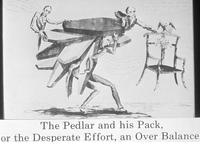1828
| Candidate |
Popular
|
Electoral
|
| Andrew Jackson Democratic-Republican |
642,553
|
178
|
| John Quincy Adams National-Republican |
500,897
|
83
|
Daguerrotype of Andrew Jackson, 1844-45 possibly by Edward Anthony (public domain) |
Andrew Jackson, not considered seriously at the beginning of the 1824 campaign, continued to gain popular support. Jackson's party could show no unity on the question of tariffs or internal improvements, and slander and mud-slinging became the "issues" of the campaign. Adams' supporters were concerned with keeping Jackson, the so-called "representative of mob-rule," out of the White House. This "Coffin Hand Bill" was printed by John Binns and depicts, at the top, the six coffins of the militiamen executed for robbery, arson, and mutiny while serving under Jackson in the War of 1812 (11A-1066502).
This cartoon also has as its subject Jackson's military career, during which two men were executed for aiding the enemy (11B-1066503). Jackson was characterized as a rowdy, drunken murderer, while Adams was pictured as a man extravagant with the people's money and stingy with his own.
Here John Binns is shown carrying the coffins from his handbill on which rest Henry Clay and John Adams, the latter determined to hold onto the chair of the Presidency (11C-1066504). His determination, however, was no match for the rising tide of democracy that elected Andrew Jackson.





